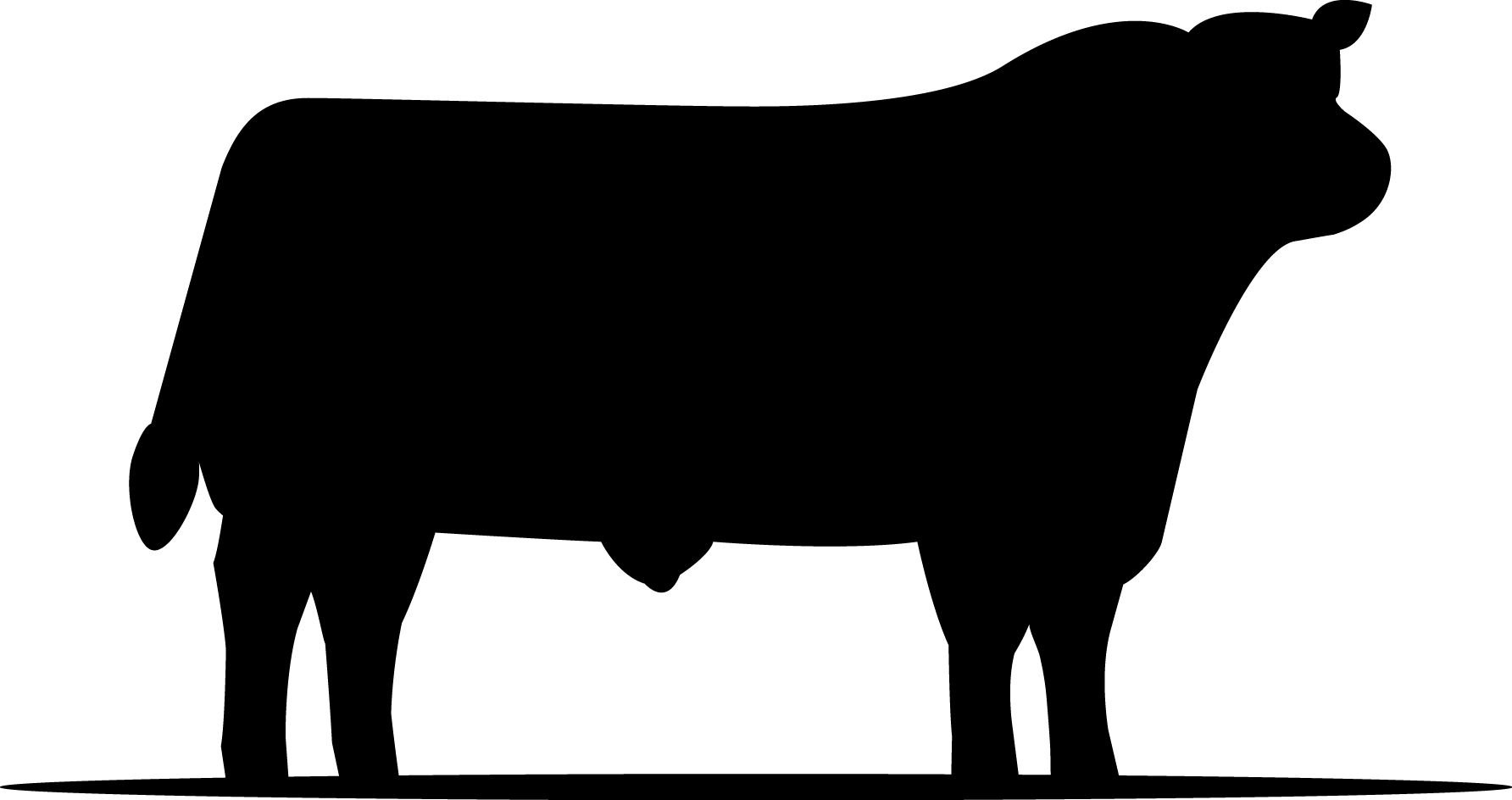The highly anticipated YDP Senior Conference 2019 took place over the course of the weekend of the 22nd of March 2019. The event took place in Nantwich on the outskirts of Cheshire, where the delegates congregated at Cheerbrook Farm Shop and Café which is owned and run by Andrew Shufflebotham the Chair of the YDP committee, along with his wife Sarah. We were joined in the evening by Angela McGregor, Past President, David Ismail, Junior Vice President and Will Chrystal new member of council and member of the YDP committee. Find out the full details of what happened at the conference below!
Introduction – Quiz and Ice-breakers
The event kicked off with a quiz formulated by Sarah with three rounds of questions on general knowledge, brand logos and music, the quiz then followed with a round of questions on Aberdeen-Angus breed facts.
Sarah had put this together for us and we are grateful to her for her efforts and the level of knowledge required to formulate the quiz, the answers were pitched just right for the gathering with no team getting 100%. Thank you for both giving up your time for the event and also for your hospitality and company upon arrival – an enjoyable start to our annual occasion.
Visit to See Beef from the Diary Bulls at Cogent Bull Stud
We were invited to the Cogent Bull stud to view a collection of Bulls that were specifically bought and tested and introduced a specialist beef to the market from the Dairy programme run by Cogent.
Our hosts Boomer Birch and Jess Simms talked us through the rationale behind the beef from the dairy project as we looked through a selection of the bulls that they had available for that purpose. We saw three breeds, British Blue, Hereford and Aberdeen-Angus. Boomer, freshly off the plane from a trip to Brazil shared his findings from the trip to the rest of the group!
The bulls had all been selected on their specific traits that were highly appropriate to the beef from the dairy herd and Boomer explained the reasons to why they had been purchased each of the bulls.
The bulls were all very much in their working clothes and kept under a strict regime to keep them in peak fitness and also in a condition that semen collection is maximised. The unit is a closed one with strict quarantine periods being observed and no outsiders are allowed beyond the glass as any disease introduction could affect and be potentially catastrophic for the business.
From the stud we moved up to the Lea Farm Dairy where Cogent had very kindly given us the use of the conference facility for the day and Boomer and Jess gave us a comprehensive explanation on what beef from the dairy was all about.
A really interesting part was the explanation of the Cogent Beef Index which is an index applied by selecting five traits that a bull can deliver to the herd, Calving Ease, Gestation Length and Calf Vigour go to make up the Ease of Management Impact or (EMI) and Calf Quality and Calf Birth weight making up the Market Value Impact (MVI). Both these indexes are given a monetary value and when the two indexes are added together this gives the Cogent Beef Impact (CBI).
This is an index that helps a dairy farmer chose which bull is most compatible with the end market and also consideration to what is most important out of the five traits to his herd performance and cash return.
Sexed Semen is also available for use in the dairy herd with many dairy farms choosing to use this as their calves will be going to a specific outlet. There is also pooled semen where three bulls are included in the same straw, this has been proven to help improve conception rates.
We all came away with a Cogent Beanie, a pen and the beef impact breeding innovation catalogue which details all the sires on the programme listed. A wealth of information for all and a highly informative morning session where we all came away with plenty of information to digest and discuss.
Unit Tour of Grosvenor Farms Dairy unit
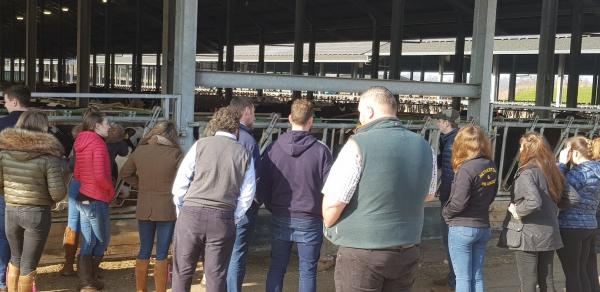
It was very kind of David Craven to take the time out to take us around the dairy unit and to avail us of the facility of the conference room for the day. A brief introduction of the Grosvenor Farms set up revealed that the livestock operation was spread over four farms in the area with each one playing its part in the enterprise in different ways. Comprising at total of 5,500 acres of arable and livestock our focus during our visit was on the dairy unit at Lea Manor Farm.
Lea Manor is home to just short of 2,000 dairy cows which are milked through the rotary sixty-point parlour three times per day. The farm is a purpose-built unit and the research that went into its design and build, taking information from units around the globe and pooling the ideas to come up with the best options was staggering!
The cows are housed in large groups in state-of-the-art barns, according to stage of lactation every care is taken to ensure that the animals are in the most comfortable of conditions whether feeding, eating sleeping or socialising. The environment is constructed to maximise natural light and the “Umbrella” style of construction ensures that air flow keeps the temperature and airflow as constant as possible.
The herd is currently averaging 12,500 litres of milk per head and the final push to take the farm up to 2,200 cows is underway this year.
The cows are all genomically tested and the top 20% of the cows are pushing out between 13,000 and 14,500 litres of milk per lactation. The top performing cows are to be sired with sexed semen to produce heifers for replacements of higher genomic potential than their mothers, so the herd moves forward fast and there are no passengers.
The balance of the herd are put through AI to beef bulls in conjunction with Cogent, with Aberdeen-Angus being the favoured sire for these cows. It was discovered that the shorter gestation length and easier calving than some of the alternatives for beef from the dairy that the Aberdeen-Angus sired mother, gave an average of 500 litres per lactation more. This gave the group food for thought as every single parameter that could be improved to increase performance had been thought of. The efficiency and precision in the management of the whole enterprise and the attention to every detail to improve performance had been addressed. A far cry from the beef industry and there was certainly a lot to learn from this for the group, but in the defence the interaction and recording of performance, three times per day in the parlour, affords the dairy industry the opportunity to be closer to their cattle than the beef industry does.
The facility has been constructed to ensure that a reduction in cow illness has been achieved and antibiotic use has been reduced in the herd by 60 %. Every possible technology is employed to ensure that anything can be picked up if an animal is out of sorts even down to a gait analysis platform that can detect if a cow is showing signs of lameness or mastitis and can be treated before the condition can become apparent to the eye.
A fantastic unit with attention to detail, and we mean every detail that can limit performance is detected and dealt with.
Speaker – Miriam Parker, Livestockwise – Animal Behaviour Specialist
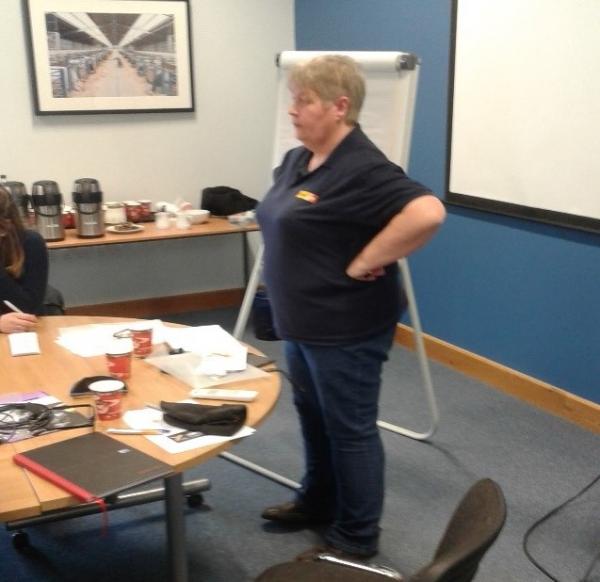
The afternoon session of speakers began with Miriam Parker from Livestockwise, a brief outline to the experience of this well-travelled lady took us all round the globe from livestock and domestic cattle hot spots to more far flung regions of the world that has led her to be a leading light in animal behaviour. This takes in a multitude of circumstances when handling animals whether it be beef sheep or any other type of animal offering a being handled from just plain old moving stock around the yard, loading trailers, handling facilities for livestock or lairage management at slaughterhouses or livestock markets.
Miriam gave the group some insights into what we do to animals to make them behave the way they do and went through some physiological facts about eyesight and range of vision that cattle in particular have, the mental make up of cattle in terms of their natural instincts that can make them behave well and they do what we want, or behave badly and lead to frustration for handlers whose reaction can sometimes make things worse depending on how they react.
She has learned a great deal from the work done on animal behaviour by Dr Temple Grandin. Dr Grandin is a designer of livestock handling facilities and a Professor of Animal Science at Colorado State University. Facilities she has designed are located in the United States, Canada, Europe, Mexico, Australia, New Zealand, and other countries. In North America, almost half of the cattle are handled in a centre track restrainer system that she designed for abattoirs. Curved chute and race systems she has designed for cattle are used worldwide and her writings on the flight zone and other principles of grazing animal behaviour have helped many people to reduce stress on their animals during handling.
Miriam shared a quiz with the delegates that highlighted a number of features of cattle that influenced how they behaved, their type of vision and the spectrum of colour that they could recognise. The position of the eyes on the head of the animal tat could affect its range of vision. She then moved on to the instincts that cattle have and why they had the style of movement and behaviour related to the information collected. The species is a grazing animal therefore its natural head position is down, and the eyes are positioned to be aware of predators, not necessarily in the domestic animal but these instincts are naturally built in. Being aware of these physiological facts can assist us when handling animals to relieve the situation where they might return to their natural instinct which is to run away from danger.
The group found that there were a number of things highlighted that can influence the animals in the show ring and when training. The question was asked can cattle learn? The answer is yes, cattle have been used for many years as draught animals and “learn” when to stop, go, and what they have to do to be rewarded for their labours. This was covered by rattling of a cake bag to bring them in or using feed to utilise the full the yolk lock system that we had previously seen on the dairy unit.
The group then brought up a scenario that happens all the time on farm loading cattle into trailers or lorries. This was broken back to the basics and the rights and wrongs of this process were explained fully by Miriam to the group with what seemed like a few “lightbulb moments” were experienced by the audience.
A fascinating and all to brief presentation that I am sure we could have listened to for a further few hours, we learned a great deal about what we do with animals when handling them and the effects on their behaviour.
Speaker – Lucy Andrews, Priestcliffe Consulting Ltd
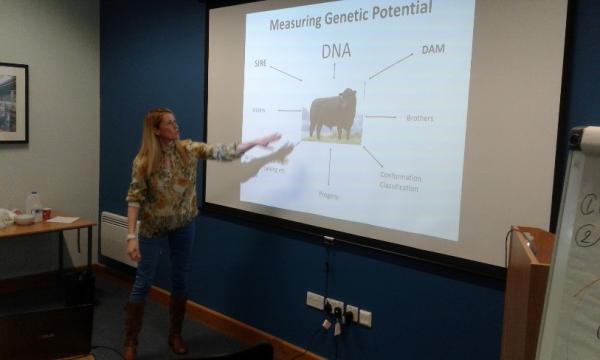
We are all aware that Genomics is the latest science that can perhaps help us breed better cattle quicker and make breed improvements with a high degree of predictability this was the subject matter that Lucy Andrews from Noden delivered to the Group.
Lucy billed herself as a Nuffield Scholar who “translates” the science in to farming language which makes it easier for the science to be understood at farm level. This was key to the very comprehensive delivery to the group who listened intently to the presentation to learn about what exactly Genomics was, the principles behind the science and the whole thing backed up with Lucy’s experience gained when working on this with the Holstien Society and the dairy industry who have since 2010 made highly significant advances in their herd performances by using Genomics as a selection tool.
Lucy went through the actual science of the Genomics tool explaining very carefully and simplistically what it was all about. Looking for consistent sets of common markers in families of cows that point towards high production. These are then compared to the phenotypic performance of the animal, she then took the time to explain that Genetic potential was only part of the story and we can influence the physical performance of the animals by everything we do to it in housing feeding management and all aspects of the environment. The Holstien Fresian breed has had the benefit of being able to use Genomic data sets from the USA and Canada to make the amount of data that is held for comparison even more meaningful and accurate.
In the past it was assumed that the breeding performance was from 50% of the dam and 50 % of the sire but this is not the case, and it is far more complex that that simple view and demonstrated this with some examples of identical human twins that look the same but have different characteristics and habits that affect the appearance of each.
The principles are that on a dairy unit if you look at them as workers you only want the best workers in the camp! Through genomic testing this can be achieved more quickly and herd improvements made by selecting the best 20% of the herd for breeding replacements and using the best dairy bulls and sexed semen decreases the “passengers” in the herd more quickly and speeds advancement and therefore profitability. This is leading to an increase in beef calves from the dairy herd because only the best performance cows are being used to produce replacement heifers for the herd.
When it comes to beef and Aberdeen-Angus there is a great deal of data available around the world to make the principle of Genomics work and work well. Angus USA have 600,000 data sets being taken every year, and this is building momentum year on year to bring the benefits of Genomic selection to their farmers. If we can access this data to make comparisons with our smaller amounts of data that makes the whole programme more meaningful and work better, it’s a numbers game. We can learn from the experiences of the dairy industry and take our breed forward by embracing this tool that uses science to help in our quest for improvements in traits that we are keen to increase our overall breed performance on.
We don’t think that this will be the last we will hear of Lucy as there is a wealth of knowledge available to us to progress the breed down the path of Genomic improvement and to be able to avoid some of the pitfalls that may delay the adoption. This will hopefully speed up the improvement of herds going forward.
Barbara Webster – Explanation of Breed plan as a selection aid to improve performance
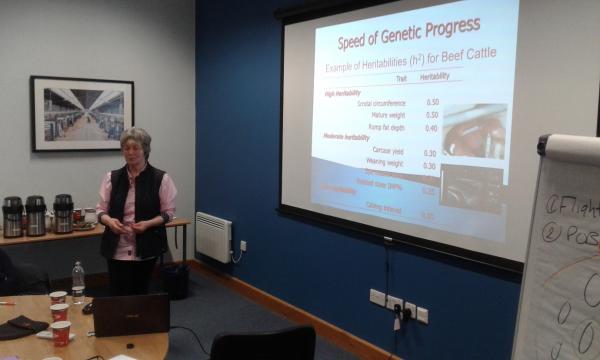
Our very own Barbara Webster took to the floor to explain how the ABRI system works in terms of being able to use the predicted performance of an animal going forward by taking data saved from the phenotypic performance of individual performance on key traits that are desirable and can be improved upon in the next and subsequent generations.
Barbara opened her presentation showing that we can’t see the genes, so we collect data and therefore stressed that the accuracy of the collected data is all important to the successful use and subsequent delivery of an improvement in performance. We look at two sides to the story in terms of maternal traits such as ease of calving and the ‘milkiness’ of the dam lines, but always with an eye on the terminal traits that are required as all the calves are not heifers. We do however need to consider the bull calves that are born and their commerciality as either bull beef or steered beef depending on the final destination.
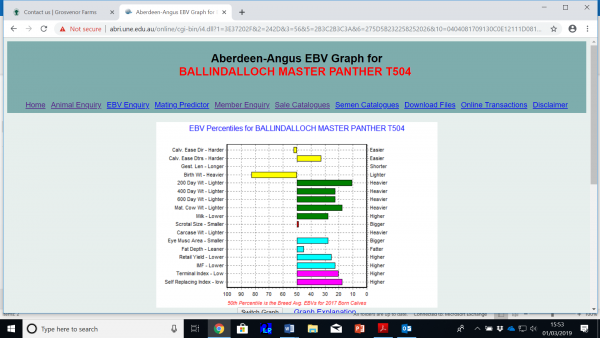
The whole system of breed improvement revolves around the breed average which is the centre line on the above graph which shows that for the specific trait that an animal has been recorded on, is it better than the breed average and by how much. By constantly using bulls that are above the centre line and therefore breed average we can keep the performance of the herd going forward.
The example above demonstrates this quite well with the yellow bars showing that despite birthweights being higher calving ease is unaffected, The green bars show a plus on all measure points for growth with 200 day weigh showing a plus that would indicate a very sufficient supply of milk by the dam of this bull helped it beat the breed average considerably and that growth potential also followed through the growing period to 400 day weights and 600 day weights both exceeding breed average.
Carcase data then follows in the light blue with this animal being better than breed average on all counts so scanning results as well as growth are better than breed average so its all good for the terminal traits that we are looking to improve.
The two pink bars at the bottom compare the Terminal traits above collectively and the Maternal traits collectively to give an overall picture of this animal’s best use going forward. This shows that this particular beast would suit either maternal traits as a stock bull or as a terminal sire.
This is all based on data collected pooled and re-calculated to give the Best Linear Unbiased Prediction (BLUP) of the subsequent generation’s performance in the form of an Estimated Breeding Value (EBV). The overall message from Barbara was to use the figures to select what traits you want to improve on but to look at all the traits as it is dangerous to just follow one. It is important to not use figures in isolation and to always keep an eye on the animal.
After Dinner Speaker – Karl Hancock
The dinner in the evening was held at the Black Lion in Nantwich where we took over the full restaurant and enjoyed a really hearty meal with the main course being Short Rib of Aberdeen-Angus beef supplied to the restaurant by Andrew from the farm shop. Following the meal, we welcomed local Aberdeen-Angus farmer and entrepreneur Karl Hancock who told us all about his business that he had developed with his daughter Laura at Whitebottom Farm near Stockport which had developed from a meagre start to now hosting up to 50,000 people per year on the 50-acre holding where he has developed a music festival business. The festivals include Buckle and Boots, Country, Blackthorn, Pop to name but a few!
This has grown and grown, and Karl took us through the trials tribulations and challenges that he faces on an annual basis to keep the events running with four major ones throughout the year and he has diversified from the events into being a highly sought-after wedding venue and is booked up way in advance.
He has changed his outlook totally on life and following a string of personal circumstances that took him down the path to where he is today, he has a totally different view on life that he recommended to the gathering.
At the festivals they run all the bars themselves and do as much as they possibly can to earn an income from their visitors. He shared a number of statistics with us one or two stick in the memory which were that each festival goer will spend an average of £60.00 at the bar during the festival.
He also sells his cattle through the festivals, when they are ready for slaughter, he has them turned into burgers, and frozen down to sell at the festival making the carcase return to about £15,000! We guess that is really the way to make cattle pay!
There were many other add ins to the festivals, accommodation tents that can be hired by festival goers and a really interesting insight to a diversification project that has led to a thriving business as it is today.
Instead of farming animals and stock, his view is that he now farms people, in his view it is exactly the same principle of making full use of your resources to make as much profit as you can from what you have available. He encouraged our delegates to think outside of the box and discount nothing until it has been tried and no matter what to persevere and you will come through!
Thanks to Karl who joined us for the full day on the Saturday, we hope that he got as much from the conference as we gained from his talk to us.
The nightlife of Nantwich was then the target with the host leading the way around the sights and we believe cutting some strange shapes on the dancefloor ably encouraged by the delegates!
Butchery Demonstration and Cheerbrook Herd visit
The programme on Sunday was to visit the farm shop and Café of our host, Andrew Shufflebotham, we enjoyed breakfast in the Café and got to see the end game, this included a demonstration of a side of beef being cut up and made ready for retail in the shop. This was followed by a tour of the Cheerbrook herd and the progeny which an invitation was open to all of the delegates to take part in.
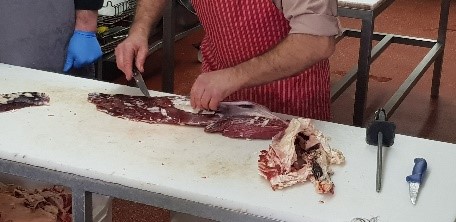
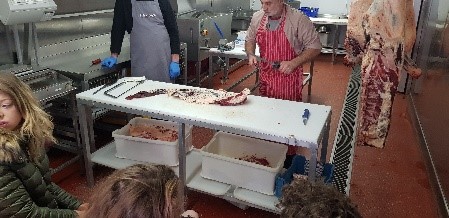
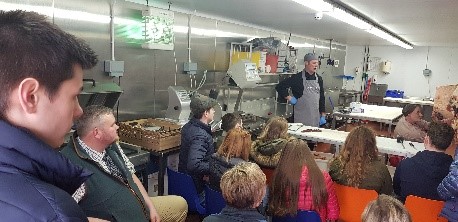
Andrew and his shop butcher Tony took the group through a step by step breakdown on the turning of a carcase into retail ready joints.
Tony started by butchering the forequarter down in to usable meat with Andrew giving us a running commentary of the process. Andrew explained what each of the components was through the process and the use that they would ultimately be put to as their final destination in the shop counter.
The basic rule of thumb is to not generate any waste and the care taken by Tony to not have any meat connected to the fat or fat connected to the meet was really apparent. Andrew also produces a range of ready meals so all the cuts on each carcass have their place and nothing goes to waste. The trimmed fat is owing to the style of butchery added back on to individual muscle cuts to aid the cooking process as basting fat, they also manufacture and sell the dripping.
The type of cutting that suits Andrews trade is “continental seam butchery” that means all the muscles are taken apart individually and trimmed accordingly with a great deal of the connective tissue taken out from between the muscles to deliver a really good eating experience. Tony then moved on to cut up the hind quarter and the commentary from Andrew continued to keep the attention of the audience and also the interest in what was happening. This was the high value cuts that were now being produced and a great interest in the values of each of the cuts was shown and also this demonstrated that the cutting of a carcass and the carcass balance of the expensive and inexpensive cuts on the retail counter is highly important to ensure some profit is left at the end of it all.
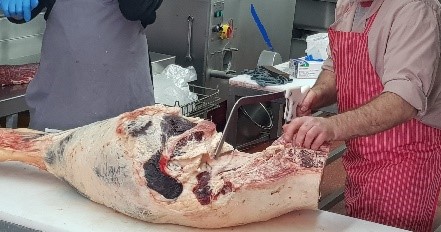
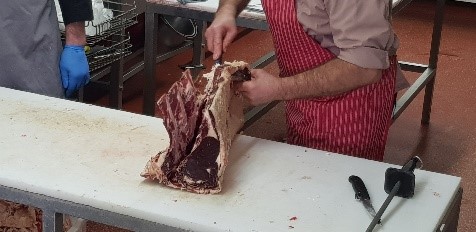
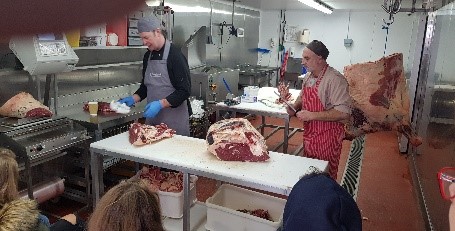
There was discussion on the overheads that needed to be taken into account and this was all extremely interesting and led to a great topic for further discussion for the delegates.
After the butchery demonstration was complete there was then the opportunity to look around Andrews cattle who obliged by when we entered the field by moving as far away as possible. This allowed for a great walk on a wonderful sunny afternoon to see what the Cheerbrook herd breeding was all about.
Cows outwintered near to the farm shop on stubble with silage fed in rings, they looked really well to say that we were just coming out of winter. Andrew did share that we possibly would not have had such a pleasant walk if the weather had not been so kind.
We then returned to Andrews Farm at home for a look at the progeny of the cows and some discussion on the breeding of the cattle at home and why they were being kept and the background of each Bull and Heifer was discussed followed by a cup of tea and a slice of Cheerbrook farm shop Lemon Drizzle cake.
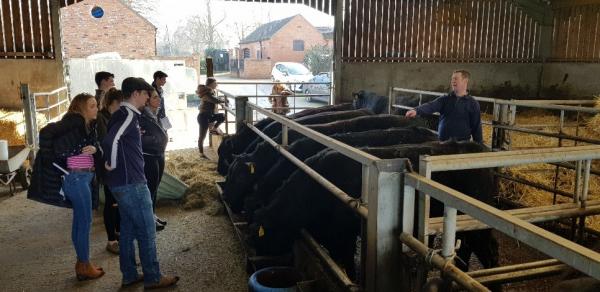
This gave a useful opportunity to get feedback from the remaining party on the weekend which was thoroughly enjoyed by all and also the restructuring of the Youth Development Programme going forward into 2019 and beyond.
The overall feedback from the event was that it was a fantastic, fun-filled and educational experience with content, visits and speakers all receiving the big thumbs up from all concerned. Everyone went away from the weekend with lots of ideas, hints and tips to take away and utilise in their own day to day working life. We would like to thank all of those involved in making this event, it is greatly appreciated by all!

